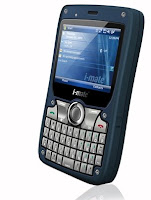SAP and
Sybase this week
announced a non-exclusive partnership to deliver mobile software applications for SAP on a wide variety of mobile
handhelds,
iPhones, Windows Mobile devices and
Smartphones.
Bill
McDermott, president of global field operations for SAP explained that the collaboration “will lay the foundation to further mobilize SAP’s great content and functionality -- and move that content and functionality into the hands of the mobile workforce."
What do they mean, "laying the foundation." Nobody can use a foundation on an iPhone, someone must build the application. I wonder how this will work?
"The mobile enterprise worker is now the most important worker, because that’s the worker that’s touching the customer, the partner, and the supplier,”
McDermott said. “This worker relies on smart devices and uses the power of calendar and email -- in addition to, now, the enterprise application functionality of SAP...there will be 300 million smart devices in the hands of mobile workers by 2013 – that’s nearly 100 percent growth from where we are today – and there will be 1 billion mobile users in the nest few years.” He added that “seventy percent of companies are planning to mobilize [business] applications [and get thim] into the hands of their knowledge workers.”
I do believe this could be a smart move for Sybase, as SAP has millions of enterprise users, but I wonder why it is a non-exclusive relationship. Does SAP really think multiple companies can afford a broad based mobile SAP development effort in this economy? I wonder if this relationship is really only about the mobile synchronization and mobile database technology that Sybase has. I wonder if Sybase will simply integrate their syncing and database technology with SAP Netweaver and leave other software developers to build the actual mobile applications. Is this what they mean by "foundation?" This seems the most likely scenario to me.
At the same time, “we are in a new reality in this economy, and companies are looking to extend the value of their existing core IT investments,” McDermott said. As such, many companies are looking for highly integrated “out of the box” solutions that will save them on integration costs and ongoing maintenance of complex systems.
Who is paying who for the "out-of-the-box" solutions? Is Sybase investing in the development of mobile SAP applications, or is SAP paying the bill? The task they have announced is enormous. Of course the details are vague, so maybe it is just hype. I have worked on many mobile applications and the suite of products that SAP has is large. This would be a monumental task, and then how do you create user interfaces for so many mobile devices with different configurations.
I am very interested in understanding how they will deliver the actual mobile software applications. Supporting all of the mobile devices with device specific features is too hard for Sybase or SAP to do on their own. Even Google said there are too many mobile devices and Smartphones with different configurations and features to support them all. There is a limit to what can be done by any 2 companies. I would guess that Sybase would begin selling a "mobile software tool kit" so that other systems integrators and partners could help build out SAP applications with device specific features that run on the Sybase mobile database and synchronization platform.
Here is another interesting observation. I did not see Sybase's mobile division, iAnywhere mentioned in any of the associated press releases or articles I read on this announcement. They did not role out their iAnywhere Management or the iAnywhere products. Hummm...what does this mean...?
Follow this link for the latest update on the SAP and Sybase partnership.
***********************************************
http://mobileenterprisestrategies.blogspot.com/
***********************************************

